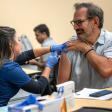Note: This research was supported by a CTSI Strategic Opportunities Support (SOS) Pilot Award.
By David Jacobson, UCSF School of Pharmacy
It can take just the flick of a genetic switch for breast cells to kick-start the normally well-regulated process of growth seen in puberty, pregnancy, or the menstrual cycle—or the mutation of that switch to initiate the unchecked proliferation of cancer.
What happens next depends on whether their cellular neighbors follow their lead, ignore, or exile them. That’s because tissues are not mere collections of identical cells but rather communities working together to carry out tasks.
So, under what conditions will breast cells respond to their fellow tissue-citizens urging them to grow their gland’s capacity—or inciting them to run amok in a cancerous riot?
According to a new study led by Jennifer Liu, BS, and Zev Gartner, PhD, under certain conditions, cells primed for growth are more likely to lead to changes in tissue structure (and produce bigger structural changes) when adjacent cells are less growth-activated, as opposed to when they are amidst similarly primed cells.
Read more via the UCSF School of Pharmacy




